

|
| DEUTSCHLAND | GERMANY |
| Bundesland: Sachsen-Anhalt | Saxony-Anhalt |
| Stadt: Magdeburg |
Magdeburg, capital of Germany's state of Sachsen-Anhalt, is situated at an elevation of 50 m on the river Elbe. The first mention of Magadoburg is found in a document of AD 805. The town proper, together with monastery St. Mauritis; was founded by King (later Emperor) Otto I in 937. The monastery received important privileges in 965. The first cathedral was built by Otto I in 955 and Magdeburg became the seat of an Archbishop in 968. The formal charter of the town's rights of 1188 (Magdeburger Stadtrecht) became the basis for many town charters during the following centuries. Magdeburg joined the Hanse federation of trading towns around 1300. The town grew steadily and already by around 1460 could boast 14 churches and a fortification with 14 gates. The residence of the Archbishops was moved to Halle in 1503, and the Reformation was introduced to all churches of Magdeburg in 1524. Despite being banned by the Empire in 1547, Magdeburg defended its Protestant faith in 1550/51. The first Protestant mass in the cathedral was held in 1567. However, Magdeburg was conquered and almost completely destroyed by the Imperial troops under general Tilly in 1631. After the end of the Thirty Years' War in 1648, the former status of Magdeburg as a Free Imperial Town was not reinstated. In 1680, Magdeburg became part of the Electorate of Brandenburg and was transformed into the strongest Prussian fortress. After a short period of French government as part of the Kingdom of Westphalia, Magdeburg became the capital of the Prussian Province Saxony in 1815. During the late 19th century, Magdeburg became a centre of machine industry. The fortifications were dismantled in 1870, and the formal status of a fortified city was dropped in 1912. At the end of World War II, on 16 January 1945, Magdeburg was largely destroyed by an allied bomb raid. Almost 60% of the whole town and 90% of the old town centre were destroyed. After the war, parts of the old town were renovated.
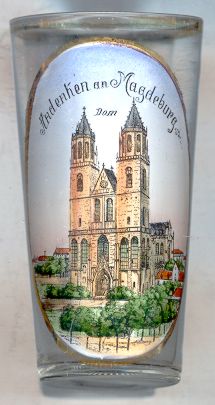
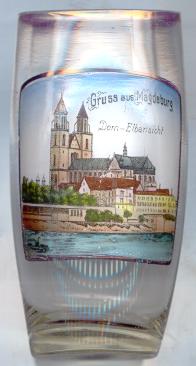
The  Dom (Cathedral) Sankt Katharina und Mauritius [left, no. 1155;
right, no. 803, and below, no. ]
was erected on the foundations of the original
cathedral that had been founded by Otto I in 955 and was destroyed by a fire in 1207. The chancel and its chapels were
built from 1209 until 1220. The second building period of 1220–1235 included parts of the chancel and the nave.
Finally the nave was extended to reach its present length of 120 m between 1274 and 1363. For more than 100 years no
further works were carried out. The church was finished by the addition of the towers (104 m high) in 1477–1520.
The church still retains some parts of the older, Romanesque church, most notably the tomb of Otto I (912–973,
King 936; Emperor 962). After World War II the cathedral was reopened in 1955.
Dom (Cathedral) Sankt Katharina und Mauritius [left, no. 1155;
right, no. 803, and below, no. ]
was erected on the foundations of the original
cathedral that had been founded by Otto I in 955 and was destroyed by a fire in 1207. The chancel and its chapels were
built from 1209 until 1220. The second building period of 1220–1235 included parts of the chancel and the nave.
Finally the nave was extended to reach its present length of 120 m between 1274 and 1363. For more than 100 years no
further works were carried out. The church was finished by the addition of the towers (104 m high) in 1477–1520.
The church still retains some parts of the older, Romanesque church, most notably the tomb of Otto I (912–973,
King 936; Emperor 962). After World War II the cathedral was reopened in 1955.
A famous figure of Magdeburg's history is the inventor Otto von Guericke (1602–1686). He is most famous for his experiments using copper half-spheres to produce an experimental vacuum proving the finiteness of air pressure and calculating its magnitude. An original pair of these half-spheres, built in 1663 and intended for a presentation at the court of the Elector of Brandenburg, is held in the German Museum (Deutsches Museum) at Munich. Guericke also was elected mayor of Magdeburg in 1646.
The famous Baroque composer Georg Philipp Telemann (1681–1767) was born in Magdeburg. The music festival 'Magdeburger Telemann-Festtage' was founded in 1962.
The
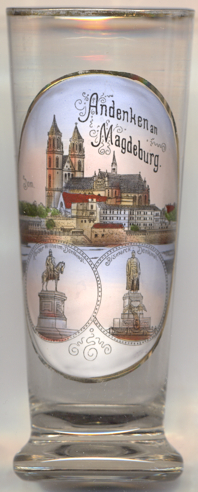
The  monument for Emperor Wilhelm I [near left, no. 3738: bottom left picture]
was created by the sculptor Rudolf Siemering. It was located in Kaiser-Wilhelm-Platz and was unveiled on 25 August 1897.
It was removed and stored away in 1942 and was finally destroyed in 1946.
monument for Emperor Wilhelm I [near left, no. 3738: bottom left picture]
was created by the sculptor Rudolf Siemering. It was located in Kaiser-Wilhelm-Platz and was unveiled on 25 August 1897.
It was removed and stored away in 1942 and was finally destroyed in 1946.
(See other monuments for Emperor Wilhelm I in this collection)
[https://de.wikipedia.org/wiki/Liste_der_Kaiser-Wilhelm-I.-Reiterdenkmäler]
 monument for Otto von Bismarck [near left, no. 3738: bottom right picture]
was created in 1899 by the sculptor Karl Echtermayer. It was located in Scharnhorstplatz. The monument was demolished
in 1951.
monument for Otto von Bismarck [near left, no. 3738: bottom right picture]
was created in 1899 by the sculptor Karl Echtermayer. It was located in Scharnhorstplatz. The monument was demolished
in 1951.
(See other monuments for Otto von Bismarck in this collection)
[https://de.wikipedia.org/wiki/Liste_der_Bismarckdenkmale_in_Deutschland]
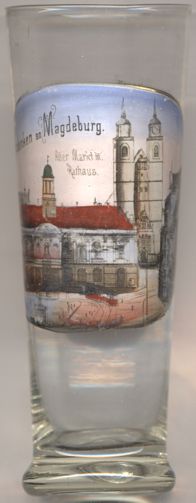
The  Old Town Hall [near left, no. 3980]
was already mentioned in 1244. Only the basement of this building, still used as a restaurant, have been preserved until today while the
rest of that building was destroyed by a fire in 1293. The town hall was rebuilt in the same year. In 1540 it was enlarged but was destroyed again
during the Thirty Years' War (1618–1648). The reconstruction was not completed until 1713. In 1889 a new wing was added on the eastern side.
The so-called New Town Hall was built to the north of it in 1905–1907. During World War II, the old town hall was severely damaged while
the new town hall burnt out. Starting in 1950, the old town hall was rebuilt mostly in its historic form. The reconstruction was completed fully
only in 1979.
Old Town Hall [near left, no. 3980]
was already mentioned in 1244. Only the basement of this building, still used as a restaurant, have been preserved until today while the
rest of that building was destroyed by a fire in 1293. The town hall was rebuilt in the same year. In 1540 it was enlarged but was destroyed again
during the Thirty Years' War (1618–1648). The reconstruction was not completed until 1713. In 1889 a new wing was added on the eastern side.
The so-called New Town Hall was built to the north of it in 1905–1907. During World War II, the old town hall was severely damaged while
the new town hall burnt out. Starting in 1950, the old town hall was rebuilt mostly in its historic form. The reconstruction was completed fully
only in 1979.
[https://de.wikipedia.org/wiki/Rathaus_Magdeburg]
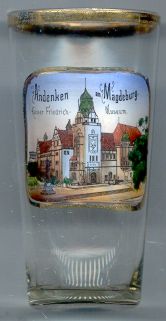
The  Kaiser-Friedrich-Museum [near left, no. 1507] was built in
1904–1906. It was named for Emperor Friedrich III, the second German emperor (ruled 99 days from 9th of March to
15th of June, 1888). The building suffered heavy damages in 1945. Today it is named Kulturhistorisches Museum (Museum of
Cultural History). Its most famous exhibit is the 'Magdeburger Reiter', the oldest stand-alone equine monument north of the
Alps. It was created around 1240 and is thought to represent Emperor Otto I (912–973, king 936, emperor 962). The
monument was destroyed during World War II but was restored after the war.
Kaiser-Friedrich-Museum [near left, no. 1507] was built in
1904–1906. It was named for Emperor Friedrich III, the second German emperor (ruled 99 days from 9th of March to
15th of June, 1888). The building suffered heavy damages in 1945. Today it is named Kulturhistorisches Museum (Museum of
Cultural History). Its most famous exhibit is the 'Magdeburger Reiter', the oldest stand-alone equine monument north of the
Alps. It was created around 1240 and is thought to represent Emperor Otto I (912–973, king 936, emperor 962). The
monument was destroyed during World War II but was restored after the war.
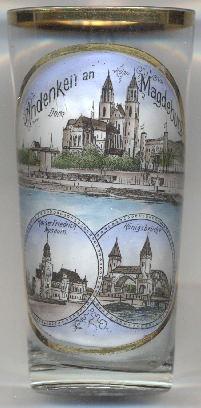
The  Königsbrücke [near left, no. 3972: bottom right picture]
was built in 1900–1903.
The central steel arch had a span of 135 metres. The abutments of the arch were built as brick towers in
Neo-Romanesque style. In 1927, the bridge was renamed Hindenburgbrücke for Paul von Hindenburg,
President of Germany from 1925 until 1934. In April 1945 it was blown up by the German army. After the war, a new bridge was
built in 1947–1952 using parts that had already been ordered and stored in 1939, as at that time already a new bridge
was planned. The new bridge was named Wilhelm-Pieck-Brücke for Wilhelm Pieck, president of the German
Democratic Republic from 1949 undtil 1960. A second bridge, the Jerusalembrücke was built just north of it in
1994–1996, and the Wilhelm Pieck bridge was renovated subsequently in 1997–1998. Since 1998, both bridges are
officially named Jerusalembrücke (north and south).
Königsbrücke [near left, no. 3972: bottom right picture]
was built in 1900–1903.
The central steel arch had a span of 135 metres. The abutments of the arch were built as brick towers in
Neo-Romanesque style. In 1927, the bridge was renamed Hindenburgbrücke for Paul von Hindenburg,
President of Germany from 1925 until 1934. In April 1945 it was blown up by the German army. After the war, a new bridge was
built in 1947–1952 using parts that had already been ordered and stored in 1939, as at that time already a new bridge
was planned. The new bridge was named Wilhelm-Pieck-Brücke for Wilhelm Pieck, president of the German
Democratic Republic from 1949 undtil 1960. A second bridge, the Jerusalembrücke was built just north of it in
1994–1996, and the Wilhelm Pieck bridge was renovated subsequently in 1997–1998. Since 1998, both bridges are
officially named Jerusalembrücke (north and south).
![[scale]](lineal.jpg)